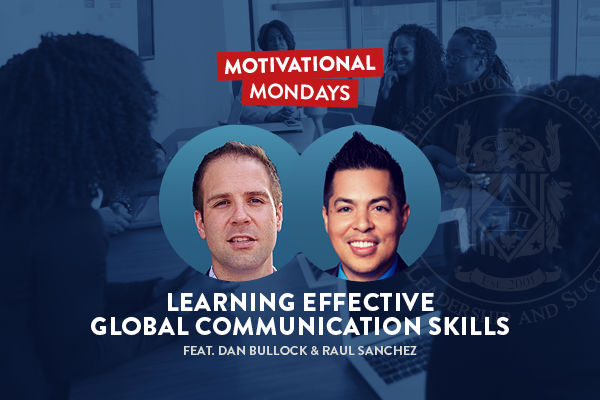Subscribe to Motivational Mondays on your favorite podcast platform!
What does the phrase “global communication” mean? How does respect for other cultures influence global communication? Is a focus on humanity important? Raúl Sánchez and Dan Bullock—both professors at New York University—have penned a new book, “How to Communicate Effectively with Anyone, Anywhere: Your Passport to Connecting Globally.” In this episode of Motivational Mondays, they join host Corey Andrew Powell to discuss the inspiration behind their book—and answer these intriguing questions.
What does the term “global communication” mean?
According to Raúl, “Global communication is a dedication to human relationships.” He notes that when they were in the process of writing the book, they researched ways to work effectively with each other, including mindful communicating and connecting. Raúl and Dan wanted to match a global mindset with a global skillset. Each chapter of their book pertains to attributes someone needs as a global communicator, from negotiation to networking to nonverbal skills.
Dan notes that if you take the term “global communication” and look at it from a visual sense, it can be viewed as a mosaic. It’s embracing the perspective that globally there is more that unites people than divides us. If you look at the night sky and see the international space station, you think about the fact that multiple countries have come together to accomplish this unified feat. The space station is a collaboration and cooperation amid various languages, nationalities, genders, etc. There are 15 nations, 5 agencies, and one singular purpose of space exploration. Dan emphasizes that “People come together over a collective vision.” Global communication is a large part of that.
The role of respect for other cultures in global communication
Raúl points out that one simple model that he thinks of is the Kaleidoscopic Perspective. A Kaleidoscope is that cylinder where a light comes through and it reveals a colorful palette of patterns. But when we experience the world that way, we're thinking about confusing mindfulness with action. Our body is one of the greatest communications instruments but with that comes possible misinterpretation of peoples’ body language. That’s where consciousness of context comes into play.
So, for example, if we think about nonverbal communication and someone crosses their arms while we're speaking, our immediate reaction may be oh, this person was closed off to our ideas. But in fact, they may simply be cold because of the temperature in the room.
Raúl also shares that Edward T. Hall identified two larger patterns of cultural communication. High context cultures—such as most Eastern cultures—are more implicit in their communication. They focus on non-verbal aspects of communication. Western cultures are more explicit and focus on verbal and written communication to understand meaning. Diversity is the kaleidoscope that exists —and inclusion is the action step.
How to use mirroring to build rapport
Dan points out that humans are natural imitators. Whenever you’re in another country or speaking another language, you want to fit in. Dan and Raúl share examples of ‘mirroring’ as it relates to effective emailing. The goal is to do some research and adjust your communication style for more relatability to your email recipient. This is a notable way to build rapport.
Dan shares that there are four elements of communication. Firstly, you need to know your audience. Then, you need to know your purpose. Are you trying to inform? Advise? Instruct? Or persuade? You are trying to create a message informed by your audience and purpose. Then you must add value so people care about what you’re trying to say.
Raúl notes that the idea of modifying your behavior for someone else doesn’t mean to lose blatantly imitating them or their culture. But rather, he shares that “When you do change your communication style to match those of others, we demonstrate that every person is as important as we are.” It creates deep respect and leaves space for empathy. It leads to more effective communication and understanding.
When engaging in professional email communication, you can craft them in different styles quite easily. However, effectiveness comes down to psycholinguistics. Dan expresses you must understand who you’re communicating with and have cognitive flexibility. You need to know when to shift between high-context and low-context cultures. Grasping these concepts requires compassion for others and incidentally successful people are often compassionate. You must understand the needs and the wants of individuals first and see their humanity. Then, cultural nuances are secondary.
How can people make humanity more important than politics? Do diversity and inclusion play a role in how you must shift your communication? Learn more about Dan and Raúl’s new book—and its positive impact on the world of global communication—in this episode of Motivational Mondays.
Listen to this episode to learn about...
- [1:11] What does the term “global communication” mean?
- [5:33] The role of respect for other cultures in global communication
- [7:43] How is their book different from others?
- [12:01] How to use mirroring to build rapport
- [17:59] Making humanity more important than politics
- [21:58] The concept of an optimized “global English”
Listen to the bonus episode to learn the importance of networking for discovery more than for results, and how humans connect over powerful stories.
Resources:
-
Connect with Dan on LinkedIn
- Connect with Raúl on LinkedIn
-
Read How to Communicate Effectively With Anyone, Anywhere By Raúl Sánchez and Dan Bullock
- Check out other Motivational Mondays episodes









